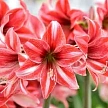
Hippeastrum
A plant from the tropics
| Latin name | Hippeastrum |
| Homeland | tropical and subtropical zones |
| Family | Amaryllidaceae |
| Cultivation | simple |
| Location | well lit |
| Temperature | 15-20 °C |
| Watering | plentiful during flowering |
| Flowering time | spring-summer or autumn-winter |
| Height | 50-60 cm |
| Transplanting | usually after flowering |
| Appearance maintenance | remove peduncles after flowering |
The genus Hippeastrum, or Amaryllis (Hippeastrum), includes more than 70 species of bulbous plants with linear dark green leaves and large funnel-shaped flowers on a high, hollow peduncle. There are many varieties used for cutting or as houseplants, they are usually called amaryllis. These varieties are the result of long-term breeding work, which is based on crossing hippeastrums and Amaryllis belladonna (Amaryllis belladonna). Of the hybrid forms, the most popular are the following. Hippeastrum palace (Hippeastrum aulicum) is characterized by red, at the base green flowers; hippeastrum bright red (H. rutilum ) - with flowers colored in various shades of red with green stripes; hippeastrum reticulatum with flowers in pink stripes; hippeastrum alien (H. advenum) with scarlet flowers. Hybrids obtained from hippeastrum striatum (H. vittatum), a species with white and red striped large tubular flowers collected in 2-5 groups and arranged in rays on the top of a hollow peduncle more than 0.5 m long, the flowers are colored in white, pink, red, orange colors with a variety of shades, often with white stripes or a border. Each one the bulb produces from 1 to 3 peduncles. The flowers last about a month. The leaves that appear later than the flowers are linear, belt-shaped, wider at the base, and bright green in color.
The genus Hippeastrum, or Amaryllis (Hippeastrum), includes more than 70 species of bulbous plants with linear dark green leaves and large funnel-shaped flowers on a high, hollow peduncle. There are many varieties used for cutting or as houseplants, they are usually called amaryllis. These varieties are the result of long-term breeding work, which is based on crossing hippeastrums and Amaryllis belladonna (Amaryllis belladonna). Of the hybrid forms, the most popular are the following. Hippeastrum palace (Hippeastrum aulicum) is characterized by red, at the base green flowers; hippeastrum bright red (H. rutilum ) - with flowers colored in various shades of red with green stripes; hippeastrum reticulatum with flowers in pink stripes; hippeastrum alien (H. advenum) with scarlet flowers. Hybrids obtained from hippeastrum striatum (H. vittatum), a species with white and red striped large tubular flowers collected in 2-5 groups and arranged in rays on the top of a hollow peduncle more than 0.5 m long, the flowers are colored in white, pink, red, orange colors with a variety of shades, often with white stripes or a border. Each one the bulb produces from 1 to 3 peduncles.
The flowers last about a month. The leaves that appear later than the flowers are linear, belt-shaped, wider at the base, and bright green in color.
Cultivation
Hypleastrums are easy to grow at home. Use a special soil mixture for bulbous plants or light, nutritious soil with good drainage. In not too spacious pots (the distance between the wall and the bulb should be no more than 2-3 cm), plant one bulb, closing it in half. By adjusting the time and duration of the dormant period and the air temperature during cultivation, you can admire the blooming hippeastrums at any time of the year. With proper care, the bulbs bloom 2 times a year. Place the plant on windows facing south-east or south-west, so how light-loving it is. After flowering, the hippeastrum is moved to a cool, dry place; it is good to transplant it into fresh soil, add ash. Pet is best to take the pots out into the open air. Periodically fed with organic and mineral fertilizers. Water regularly and moderately during the growing season.
Location
Hippeastrum is placed in a very bright place, except for the rest period.
Temperature
The growth of the flower arrow can be accelerated by heat (air temperature or warm watering), and to extend the duration of flowering, keep the temperature cooler (about 15 °C).
Watering
Hippeastrums should be watered regularly, especially during flowering. Leaves that continue to develop after flowering also need watering, at least until they start to turn yellow.
Care
After flowering, the peduncles are greatly shortened, cutting them at a distance of 5-10 cm from the base.
Reproduction
The simplest method is to separate the bulbs formed next to the main bulb during spring transplanting, when they reach a diameter of approximately 3 cm, and plant them in separate pots. They are taken care of as adult plants. Flowering begins in the 2-3 th year, when the bulb reaches a diameter of about 8 cm. You can not take daughter bulbs from too young (not blooming) or an onion that is too old. In breeding work, they are also propagated by seeds.
Diseases
Gray rot of vegetable crops (Botrytis cinerea) causes the appearance of necrotic spots on the leaves and cracks on the peduncles. In this case, the plant can be treated with a fungicidal preparation. But it is better to get rid of the affected copy, as with rotting bulbs. Aphids and thrips that cause deformation and yellowing of leaves and flowers are destroyed by treatment with appropriate preparations. From the spider mite (red or yellowish specks appear), they get rid of acaricides and maintain high humidity around the plant in the future.
Acquisition
Hippeastrum is easier to find in gardening centers than in flower shops. Buy plants with buds on long peduncles. Choose strong, healthy specimens, with strong bulbs, without spots on the peduncles.